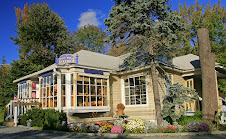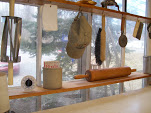
A roomy old inn it was, built in the 1840's; the kitchen was built in the 1930's, and had some excellent features, including reach-in doors built into the side of the walk-in cooler and a bakeshop with giant flour bins built right into the counters. The original tools were still there from the Depression, including a wonderful old baker's scale. There were deck ovens and what had to be the goofiest Hobart mixer I'd ever seen. The mixer was unused for years, but a search of the basement turned up all of the missing bowls, attachments and accessories. The year was 1981. We had a new President, a new Pope, and a royal wedding; things were looking up.
Now, I don't know about you, but I bond with my tools; we almost become friends over the years, and that old mixer was my workhorse. The exquisitely inefficient dough hook looked like something to catch whales with, but it made loaves and loaves of bread, miles of pasta dough, pastries, biscuits...
I stayed at that place five years, then moved on. The road after that, well. I actually did go back to work at the inn for a short time, as a business partner no less. I noticed that the old dough hook for the mixer was missing and had been replaced with a modern one. I tracked down the original and brought it back, no easy task. I just couldn't stay there, though. There were too many ghosts, and my business partner and his wife were avaricious creeps.
It was more than ten years from that point until we opened the bake shop. The next owners of the inn, truly wonderful people, were buying breads for their dining room from us. One morning at 4:30 or so, one of them came to the shop and canceled their order for that day. She then tearfully explained that the inn was on fire.
The blaze was subdued, but a lot of damage was done. Even so, the insurance company removed all of the surviving contents of the building in order to clean and restore them. In the interim, vandals broke into the inn and set another fire that laid the place down. The insurance company soon held an auction of the contents, and I couldn't refrain from attending the sale.
At auction the old tools were laid out, to paraphrase Eliot, like patients etherized upon the table. Waiting for the bidding to begin I milled about with the other buyers, chatting. Now and then I'd see a forgotten tool: an ancient balloon whisk, a giant ladle with rivets in the handle; picking them up and fondling them my reaction was visceral. And there, standing on a dolly in the middle of the room was my mixer. A quick survey showed a couple of pieces missing, but the dough hook, pastry blade and original paddle all piled themselves inside one of the bowls.
I showed no particular interest in it, or so I thought, until an old man sidled up to me and said,"You know you can't get parts for those any more."
I was shocked.
Moments later the cashier was handing me a numbered card.
Moments later the cashier was handing me a numbered card.
The bidding started loud, fast and was a little confusing to me. It took a great effort of will not to bid on the small wares. I started and stopped myself several times from chasing the woman who'd purchased the lot containing that big old riveted ladle, wondering to this day if she'd have sold it to me. But I just couldn't have the clutter in my life, could not stand to have all those memories underfoot.
I did not need another mixer at the shop, in fact. There was no room for a 20 quart floor model mixer anywhere. I didn't bid against the two guys battling it out over the old Hobart.
When the fray settled down at five hundred dollars and the auctioneer was saying "...once, going twice..." I remembered retrieving the dough hook from almost certain oblivion.
I slowly raised my number. The auctioneers head was down, though, and he didn't see me. His assistant glanced up caught sight of my card, shoving her elbow into the auctioneers ribs.
With a blinking stare he said "Five twenty five", and looking over at the fellow who'd had the highest bid he said,"five-fifty fifty fifty fifty fifty. Would five thirty five make it easier for you?"
It was obvious at that moment they knew one another. The bidder shook his head no. At the sound of the gavel the losing bidder shot me a furious look; it was then I noticed the older fellow who'd given me sage advice on spare parts standing beside him, frowning.
So there that mixer stood on the back porch of our shop for about a year, smiling at me every day as I arrived for work. When we expanded our work area, a spot opened up for the mixer and guess what. That old dough hook makes excellent croissants and baguettes!
The Hobart company ran a contest to find out who had the oldest running Hobart mixer in America, and she won an honorable mention. Manufactured in 1927, as it turned out, it would have been a vintage antique were it an automobile. And if I ever need spare parts for that mixer, I know exactly where to go. Always have. But that's a whole 'nother story.

